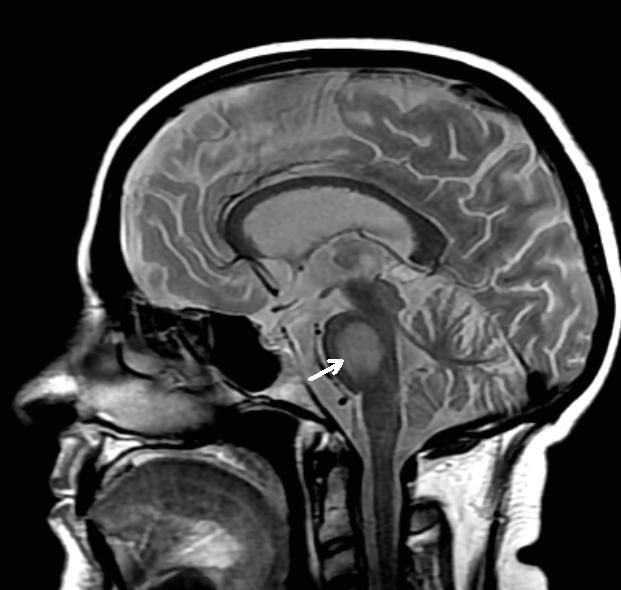Neuro Pathology - Central Pontine myelinolysis / Osmotic Demyelination syndrome
In my last post, titled "Neuro Pathology - Acute Disseminated Encephalomyelitis", I explained about Acute Disseminated Encephalomyelitis which is an autoimmune disease that could be triggered via pathogens such as viruses such as infection from Measles mumps, and rubella. Today, we will be discussing Central Pontine myelinolysis, or Osmotic Demyelination syndrome which is a result of hyponatremia being over corrected leading to the destruction of Oligodendrocytes.
Hyponatremia can be caused as a result of some disorders such as Cirrhosis, where there is fibrosis of the liver causing the hepatic portal system to have difficulty getting blood through the hepatic portal vein into the inferior vena cava leading to a high portal pressure and less blood flow through the liver, and low blood volume in the inferior vena cava. With Low blood volume, there is a brain trigger requesting your posterior pituitary to produce ADH which then acts on the kidney to increase the reabsorption of water. In this case, there is an increased amount of water than sodium in the blood leading to hyponatremia.
Hypokalemia is another cause seeing that it is the decrease of potassium level in the blood which will result in low potassium in the cells. In other to maintain potassium, sodium is absorbed into the cell to counteract the low potassium, causing the sodium in the sodium in the extracellular fluid to reduce (hyponatremia).
Malnutrition and alcoholism can lead to hyponatremia which doesn't contain sodium. Fluid will be taken in more causing water to be absorbed more into the bloodstream, reducing sodium levels in the blood. This must have occurred in a person for more than 48 hours to be regarded as hyponatremia.
Having these conditions should be treated but trying to bring up the sodium level back to normal very fast can lead to Central Pontine myelinolysis. The brain over a period of time starts to adapt to the low sodium in the blood and outside the cell. The astrocytes which are a part of the blood-brain barrier start to release glucose, and glutamine to the outside cell helping to maintain the equilibrium of the intra and extra-cellular environment. Since the brain has adapted in the early stage, an attempt to quickly add salt to increase the concentration, thereby not giving the astrocyte enough time to regulate itself and absorb the glucose, causing the astrocyte to lose water and shrink causing the DNA to fragment, and causing the aggregation (sticking together) of proteins, causing Apoptosis of the Astrocytes. This action disrupts the blood-brain barrier causing the free movement of things through the barrier. This also stimulates cytokines known as Microglia which causes the death of the oligodendrocytes leading to neurological deficits in the pons.
The demyelination usually occurs in the pons but can extend outside the pons. In the pons, it can lead to the injury of the nerves from the Cranial nerve 5 causing the inability/weakness to chew, it would also affect the cranial nerve 6 (Abducens) which is responsible for the abduction of the eye leading to diplopia, It can also affect the Cranial Nerve 7 (facial nerve) which will cause absent of facial expression, and it can affect the vestibulocochlear nerve (cranial nerve 8), causing vertigo and nystagmus. It can also affect the corticobulbar tracts supplying the cranial nerves leading to pseudobulbar palsy which will still affect the cranial nerves even when the nerve themselves are not affected, including the cranial nerves 9, 10, 11, and 12 causing Dysphonia, Dysphagia, and Dysarthria.
With Osmotic Demyelination syndrome, there are lesions that occur in the pons, knocking the motor fibers and causing weakness and paralysis in the extremities such as Paraparesis and quadriparesis.
It can also affect the reticular formation which sends visual, auditory, and somatic sensations to the cerebral cortex. With Central Pontine myelinolysis, or Osmotic Demyelination syndrome, there is a decreased level of consciousness which can progress to locked-in syndrome.
Image 1 || Wikimedia Commons || Central pontine myelinolysis

Thanks for your contribution to the STEMsocial community. Feel free to join us on discord to get to know the rest of us!
Please consider delegating to the @stemsocial account (85% of the curation rewards are returned).
Thanks for including @stemsocial as a beneficiary, which gives you stronger support.
Congratulations @eni-ola! You have completed the following achievement on the Hive blockchain And have been rewarded with New badge(s)
Your next target is to reach 1000 replies.
You can view your badges on your board and compare yourself to others in the Ranking
If you no longer want to receive notifications, reply to this comment with the word
STOP